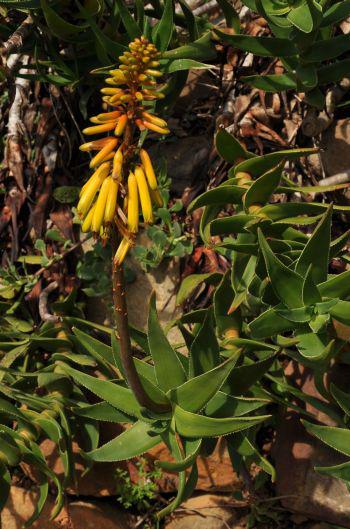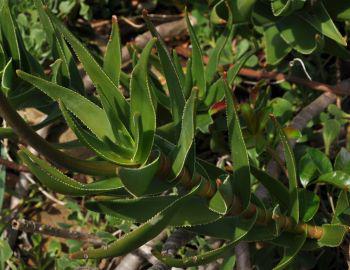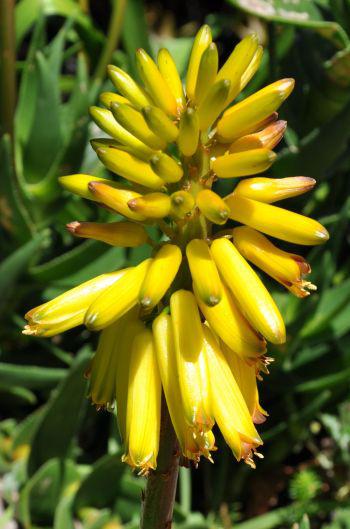Aloiampelos commixta
Aloiampelos commixta (A.Berger) Klopper & Gideon F.Sm.
Family: Asphodelaceae
Common names: Peninsula rambling aloe
Introduction
Offering a rich variety of growth forms, making excellent accent plants, suited to almost any climate and producing a flowering display of vibrant colours that outlasts many plants, aloes excite the senses and Aloiampelos commixta is no exception. This plant was previously called Aloe commixta, but the rambling aloes have been moved into their own genus Aloiampelos.

Description
Description
The slender, intermingled stems of Aloiampelos commixta sprawling over a decorative stonewall terrace or rambling over an obliging granite boulder give this unique species its name. Creeping up to 1 m tall, this multibranched shrub may be grouped with A. ciliaris, A. striatula and A. tenuior to be known collectively as rambling aloes.
The leaves are slightly fleshy, widely spaced and erectly spreading on a fine stem with distinctive green stripes on the internodes. Reaching 200 mm in length, the leaves are narrowly lanceolate and dull green, flat to slightly canaliculated (concave) and the margins are equipped with hard white deltoid teeth 1-2 mm long.

Compared to others of this group the simple inflorescence of A. commixta is somewhat stout attaining a maximum length of 300 mm. Flowering from August to September A. commixta brings a vibrant flush of changing colours to the landscape as reddish buds borne erectly spreading on the top of the inflorescence transform into fiery yellowish-orange open flowers tilted downwards towards the base. It is most closely related to A. striatula, however, its leaves are not as recurved, its inflorescences are shorter and the racemes are not as cone-shaped. The difference between upright buds and hanging flowers is also more obvious in A. commixta.

Conservation Status
Status
Van Wyk & Smith (2001) explain that south of the Cunene-Zambezi Rivers, more than 10% of all vascular plants (over 30 000 species) are found on about 2.5% of the world's land surface and at least 60% of these species, like A. commixta, are strictly confined to the region (occurring nowhere else in the world!). A. commixta is listed as Vulnerable (VU) on IUCN's global Red Data List 2009. Agricultural demands, alien species invasion, excessive collecting, urban spread and human-induced climate change combine to place the extraordinary floristic diversity found at our doorstep under extreme pressure, so much so that experts from the City of Cape Town's Biodiversity Management Department have dubbed the Cape the, "biodiversity mega-disaster capital of the world" (Holmes et al. 2008).
All aloes, including Aloiampelos are protected by environmental legislation in South Africa. Without a permit from the provincial Nature Conservation authority and consent from the landowner it is illegal to remove them from their natural habitats.

Distribution and habitat
Distribution description
Aloes and the related genera may be found all over Africa, Madagascar, southern Yemen and southern Saudi-Arabia. A. commixta, however, has a very limited distribution being confined to the acidic, sandy soils and winter rainfall areas of the south-western Western Cape between 0 and 200 m above sea level. This succulent species is thus endemic to the Cape Peninsula; its limited range extends from Fish Hoek to Slangkop, the Bonteberg being the northern boundary, and it occurs in masses at Glencairn, Red Hill and Simonstown.
Derivation of name and historical aspects
History
The knowledge of South Africa's aloes is deeply intertwined with the history of the land. From early Portuguese explorers like Bartholomew Dias and Vasco da Gama in the late 1400s to the establishment of the Dutch settlements in the 1600s and during countless inland expeditions by legendary travellers, plants were being collected and described, the land was "opened up" and amongst other things the present day knowledge of the genus Aloe was being formulated. Hendrick Bernard Oldenland was Superintendent of the Company Gardens at the Cape in 1695. He was an accomplished botanist and collected and dried specimens of a large number of South African plants. A. commixta is number 14 in Oldenland's "Kruid Boek" (herbarium) and was one of the first aloes cultivated in the Dutch East India Company's Garden at the Cape. Today there are approximately 126 aloe species known in South Africa. The exact derivation of the word aloe is unclear. It is suggested, however, that it comes from the Arabic alloch or alloeh, describing species which were used medicinally. It may have also been derived from the Greek aloë denoting the dried juice of the aloe leaves.
In 2013 the genus Aloe was revised and split into a number of genera, including Aloiampelos. This name means ‘climbing aloe’, from Aloe and the Greek word, ampelos, meaning ‘climbing plant’, referring to the climbing or rambling habit of this group of aloes. The species name commixta is from the Latin commisceo and means 'mixed together', perhaps referring to the tangled mixed up stems of this sprawling plant.
Ecology
Ecology
Most succulents make use of striking and showy flowers which aids the particular method of natural pollination used by most aloes - ornithophily (pollination by birds). This relationship between plant and pollinator is an example of symbiosis; an intimate relationship between two or more organisms of different species. Between A. commixta and its specialized pollinators (honey bees and sunbirds) both partners benefit from the association. This mutualistic relationship is described as a, "particularly close form of mutualism" as neither the plant nor the pollinator can survive without the other (Smith & Van Wyk 2008).
Uses
Use
In 330 BC Aristotle convinced Alexander the Great to conquer the island of Socotra to secure the main supply of aloes. Aloes were also of military consequence as they were used to treat upset stomachs and open wounds in the soldiers' army barracks. Today aloe sap, pulp, gel and crystals are used more and more in complementary medicine to treat a variety of ailments, generating revenue of 100 billion US dollars per annum. Aloes have thus been a precious resource throughout the centuries. Taken as a laxative, aloe juice is acquired after fresh leaves are boiled in water to make a decoction. Dried crystals of the leaf sap can be taken orally also as a laxative and for arthritis. The raw bitter sap is used to treat conjunctivitis and sinusitis. The thick, golden-brown leaf gel is applied topically to sooth skin irritations, cuts, bruises and sun burn. The primary active ingredients in the leaves, responsible for the medicinal qualities, are the compounds known as aloin (found mainly in the sap), complex polysaccharides and glycoproteins (mainly in the pulp).
Growing Aloiampelos commixta
Grow
Aloiampelos commixta is a Cape Peninsula endemic and as such its growing conditions in your garden should, as far as possible, mimic the temperature and rainfall conditions of the Cape. Growing naturally in a winter rainfall area A. commixta does not grow well in open beds in summer rainfall regions, unless the beds can be protected from unseasonal rain. Aloes should be watered liberally during the growing season and during the warmer months. During the resting period do not drench the plant as this will lead to stem and root rot. The rains start early in the winter rainfall regions of South Africa, so A. commixta can be given more water from as early as March through to September. Aloes do well in areas with some degree of humidity and most aloes flourish under high temperatures. All Aloe species need plenty of bright light, especially as fully grown plants. Soils should be sandy and well drained with a pH around 6.5 to 7.5.
A. commixta may be propagated from seed and stem cuttings. When using the seed, do not sow it too deeply in the tray and cover with some coarse sand. This helps with drainage around each seed. Temperature is a key element for successful propagation. Maintain the temperature around 25-35°C. The tray should be placed in a well ventilated area with up to 40% shade, especially in summer. Do not overcrowd seeds in the tray. When propagating A. commixta using stem cuttings collect material from the parent plant and simply insert into a sandy medium.
References
- Holmes, P., Wood, J. & Dorse, C. 2008. City of Cape Town biodiversity report 2008. City of Cape Town.
- Oliver, I.B. 1993. Grow succulents. SANBI. Cape Town.
- Reynolds, G.W. 1950. The aloes of Southern Africa. Balkema, Cape Town.
- Smith, G.F. & Van Wyk, B.-E. 2008. Aloes in Southern Africa. Struik, Cape Town.
- Smith, G.F. & Van Wyk, B.-E. 2003. Guide to the aloes of South Africa. Briza, Pretoria.
- Grace O.M., Klopper R.R., Smith G.F. et al. 2013. A revised classification for Aloe (Xanthorrhoeaceae subfam.Asphodeloideae). Phytotaxa 76(1)7-14.
Credits
Julia Dabush
Kirstenbosch National Botanical Garden
April 2010
Updated Oct 2016
Plant Attributes:
Plant Type: Scrambler, Succulent
SA Distribution: Western Cape
Soil type: Sandy, Loam
Flowering season: Spring, Winter
PH: Acid, Neutral
Flower colour: Yellow, Orange
Aspect: Full Sun
Gardening skill: Easy
Special Features:
Horticultural zones







Rate this article
Article well written and informative
Rate this plant
Is this an interesting plant?
Login to add your Comment
Back to topNot registered yet? Click here to register.